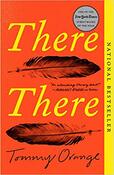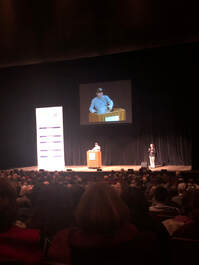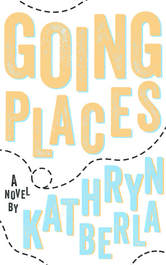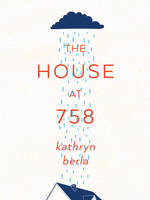|
Summary: We all came to the powwow for different reasons. The messy, dangling threads of our lives got pulled into a braid--tied to the back of everything we'd been doing all along to get us here. There will be death and playing dead, there will be screams and unbearable silences, forever-silences, and a kind of time-travel, at the moment the gunshots start, when we look around and see ourselves as we are, in our regalia, and something in our blood will recoil then boil hot enough to burn through time and place and memory. We'll go back to where we came from, when we were people running from bullets at the end of that old world. The tragedy of it all will be unspeakable, that we've been fighting for decades to be recognized as a present-tense people, modern and relevant, only to die in the grass wearing feathers." (from Goodreads) My Ramblings: I read this book as part of my Indigenous Lit and the West course at Montana State University. It was... difficult. It was also pretty amazing. Told from multiple viewpoints the story unravels in a spiral. You are introduced to characters, introduced to their lives and struggles and hopes. Slowly connections start to form, a relative here, a passing acquaintance there. Each story is both completely individual and one thread in the whole tapestry. In that way I found myself deeply invested in the characters and their chapters, while also finding myself jumping backwards to double check if I had really read what I thought I read. The context changing as the spiral tightens. Everything leading to the powwow and the events that unfold there. I won't go into it, to talk about where it all leads is to spoil the ending and the ending is both shocking and the inevitable conclusion of the paths the characters were all walking. There, There somehow manages to be both uniquely Native American while providing a universality that allows those who don't share this specific history to make a connection nonetheless. There, There deserves all the accolades and awards it has received. If you haven't read it, do. It's one that I know I will refer back to and read again. A Question on Analyzing Books: So like I said, we read this book as part of my Indigenous Lit course and as part of that course we dug deep into the books we read. Stories by and about Native American writers like Morning Dove and Tommy Orange. Books published 100 years ago and those published just last year. As we read we looked for meaning, tied the stories on the pages to the events occurring at the time, argued about what the author might have meant by a reference. Through it all we worked together, and sometimes against each other, to figure out why these books in particular were important, why the author wrote them, what importance they might have seen. Sometimes there were interviews that we could reference or other articles that would give insight to what the author felt or meant, but more often then not it was just us, guessing at meaning by using the clues were were able to pull from the story and our knowledge of the time the story was set in or even written in. It's a fun exercise and I enjoy the debate, of seeing where our personal biases and experiences color our interpretation. Still, something about it has always left me on edge, because I have seen in teaching where a question on a state exam or a story in an ELA unit will give a definite answer to something in a story only to have the actual authors of the story come out and say "well, that's not what I meant at all". All of this is to say that whenever possible I try to ask the author, and I try to impress upon my students to ask the author. Even if they don't answer, at least there is an attempt to get to the heart of it.
For me I was delighted to see that he lectured much in the same way I teach. Basically, here's what we should absolutely remember to say, but also let me tell you this cool story. Orange was concerned that he was not a lecturer, but I found the whole thing pretty spot on. At there end there was time for questions, which is where this whole thing really comes back together for me. I was lucky enough to be able to ask the last question of the night and I chose to ask about something that had come up in our discussions in class. There, There opens with what we generally categorized (in class) as a non-fiction essay prologue that speaks to the violent history that Native Americans had to deal with in the US. There is also an interlude that delves back into those topics. As a class we talked about the importance of the prologue and why Orange might have included it. We talked about how it gave the book context, gave it a backstory. We talked about how if you were not a person with a knowledge of how Native Americans were treated in the US, it would help frame the story to come. So last night at the lecture I asked Orange why he had chosen to write what was essentially a non-fiction Prologue before moving into the book proper. His response was pretty simple, and made total sense, while not at all being anything we had discussed in class. Orange first said that he didn't even know that he had written a non-fiction essay. That it was just writing and the information was important to the story. He also said that what he loves about prologues is that you don't have to follow any of the rules that you set for the rest of the book. His book is told from multiple perspectives set in the present day, this important information didn't particularly fit into that format, so it became the prologue. He said the other great thing about a prologue is that if you're a person who hates a prologue you can just skip it and still get the story. This information, while important, wasn't part of the narrative proper and so if you read it, the information enriched the story, but if you didn't read it, you would still get the story. In all the analyzing we did, these weren't things we considered. That isn't to say the things we spoke about were wrong, they just simply weren't the whole picture. Which brings me back around to my dilemma. How do you have students (or adults for that matter) make personal connections and analyze literature while also balancing the authors actual perspective? Do authors like us to reach out and ask, and if so what is the best way to do so? What if the author is no longer living- is there a way to figure it out or is it enough to simply say "we may never know what they truly meant, but here is what we can infer"? These are questions that I don't have an answer to, but I'm glad I was given the opportunity to ask Orange last night, his answer enhanced and shifted my reading of his book, which is always an exciting thing. While there is no video of the lecture I attended last night, I am attaching a video of Orange speaking at Politics and Prose at the Wharf in June 2018. He reads from the book and at the 12:20 mark he specifically speaks to the prologue.
0 Comments
Book Summary: Hudson Wheeler is a teen for whom everyone had high expectations, but since his father was killed when he was ten, he's felt unmotivated to pursue much other than his art. During his senior year, he decides to home school, thinking he will get to relax and focus on his two lazy businesses. But instead, he experiences love and rejection for the first time; meets an athletic girl who shows him by example what it means to be a man; and solves the painful mystery of the WWII vet whose poignant plight forces Hudson out of the comfort zone of boyhood. In Going Places we see the main character Hudson building some very unlikely relationships with both Fritzy and Mr. Pirkle. What was the inspiration for building these relationships for Hudson and what role do you think relationships like these can play in someone’s life? I love to include cross-generational relationships in my books because nobody lives in a vacuum, especially teens. Young adults have multiple generations involved in their lives if they’re lucky. Often, the relationship with the parent can be fraught with tension during high school, but with a grandparent or someone of a grandparent’s generation, things can be more relaxed. I’m a firm believer the young have much to learn from the wisdom and experience that age brings if they truly take an older person to heart and manage to hear and see them for the young person who once lived inside them. I also believe that young adults have much to offer the elderly, not least of which is their enthusiasm for life, their ability to live in the moment, and their fresh take on events. As far as Hudson’s relationship with Fritzy, I know we expect to see romance in young adult literature, but my point is that, although teens are raging with hormones, true friendship is more valuable than anything in the world and is the relationship that’s most likely to last through the ages. How many high school romances are still intact ten years after graduation versus how many friendships? In my personal experience, many friendships are still intact decades later, although I do have a son who’s married to his high school sweetheart. I love Fritzy and if I could have brought her to life, I would have chosen her to be one of my best friends at that age. On a personal note, I was not a fan of Alana and the way she treated Hudson, and spent a fair bit of time getting legitimately angry at her, which really speaks to how well formed her character was. How does the process differ in writing inherently good characters like Hudson and writing a character who makes some pretty poor decisions like Alana? Is one more fun to write then the other? I love both Alana and Hudson. Of course, Hudson is easy to love because he has such a good heart and he’s a real people person. But Alana is like a bird with a broken wing. She’s been hurt in life and because she feels abandoned by her own mother, she can’t ground herself or see beyond her own pain. She comes off as selfish and she is. But I think her selfishness is just self-preservation. It’s the way she deals with pain. I see Alana having a string of unhappy relationships in her life, but I hope one day she’ll seek out therapy and realize what she’s doing to herself and to others. She’ll come to realize that she needs to love herself before she can love others, and then she’ll be able to mend her broken wing and fly. So, I suppose I liked writing Alana even more than I liked writing Hudson, because it’s so hard to love her and understand her. Was there a moment in your career that made you realize that writing was what you wanted to do with your life’s work? I’ve always wanted to write but I wasn’t always ready to write. I had to prepare myself through living my own life, self-reflection, and reflecting on the lives of others. I also had to read hundreds and hundreds of books, probably thousands. And then one day I realized I was ready to tell my own stories. Do you have any projects coming up that you’d like to tease to our readers? In August, my first adult novel comes out (THE KITTY COMMITTEE). It’s what’s categorized as women’s fiction, or sometimes upmarket or book club fiction. It’s available for pre-order on Amazon which describes it in the following way. “The Kitty Committee of Grace’s youth was ostensibly a group of friendship and support. But the friends fell victim to the ringleader’s manipulative personality and recklessness, which set the girls on a course of vigilante justice, culminating in an act that will forever change their lives, an act that becomes their shared secret.” Think THE GIRLS meets PRETTY LITTLE LIARS. My young adult novel about parallel universes (working title is S.P.I.T.) is nearly complete. I've had a chance to read both Going Places and one other book by Berla, The House at 758 and I'm really looking forward to checking out Berla's upcoming books. If you haven't had a chance to check out Berla's books, you can pick them up at your favorite bookstore or online.
Thank you for stopping by to answer our questions about Going Places! We can't wait to read more. Summary:
Sixteen year old Krista is still grieving the untimely death of her mother when her father's new girlfriend moves into their home. He's already moved on and wants Krista to do the same, but she's not ready to resume a normal life yet. Distancing herself from those around her, Krista spends all of her time obsessively watching a mysterious house, the house at 758. When a fellow classmate, Jake, takes a sudden interest in her, Krista feels excited for the first time in two years, but feelings of guilt consume her, and she ends up pushing Jake away. It isn't until her grandfather makes a surprise visit from Venezuela that Krista is finally able to confront her grief and begin to let things go. My Ramblings: I recently read and reviewed Going Places by Kathryn Berla (out March 2018) and then got the opportunity to pick up The House at 758. I love discovering new (to me) authors and titles because it's a bit like opening a present- you aren't sure what you are going to find inside, and as you open it you find something that's just right. That's kind of how I feel about Berla and these two books right now. Two months ago I didn't even know they existed, and now they've become books that I'm eager to order for the library and pass on to my students. I don't want to give much away here, because the story includes some fabulous reveals, so this review will be short and sweet. This book, like Going Places, focuses on a kid who is hurting, who is trying to move forward after a tragedy and who is trying to figure out how to exist in a world that isn't familiar anymore. Here we find Krista still reeling from her mother's death. She's coping in ways that other people don't understand, in ways that are a little odd, and even in some that could be potentially dangerous. When her best friend goes away for the summer, Krista is a bit rudderless. It takes a few unexpected relationships to shake Krista and make her take a hard look at what she wants and if she wants to let herself be vulnerable again. Berla does a great job telling Krista's story. Anyone who has lost someone will find something familiar here, from the anger and grief, to the feelings of being alone even when you are in a room full of people. They'll recognize the guilt and the feelings of "what if?" that fill Krista's mind, even if they are lies that she is trying to get past. What I love most about this book is that there is no big grand happy ever after. There is just life. In the end you get the sense that Krista's life isn't perfect, but that she'll be okay. For me that's a great message not only for me as a reader, but for me to send my students as their librarian. I'm always trying to find books that reflect real life (even those that fall into the realm of fantasy and sci fi), I want them to be able to see themselves somewhere in the pages, and I think Berla does a great job here. Krista is damaged and she's hurting, but she'll be okay in the end. |
About
Home of the ramblings of an avid reader. In my spare time I also run, ride, teach, go on adventures and get into shenanigans. Find me here: Goodreads Etsy TikTok Categories
All
Archives
October 2022
|





 RSS Feed
RSS Feed








